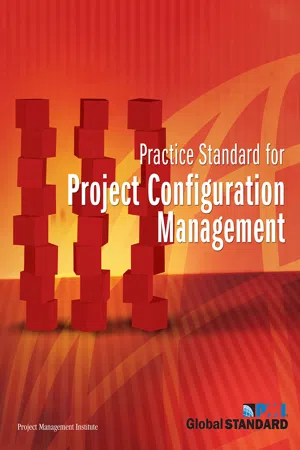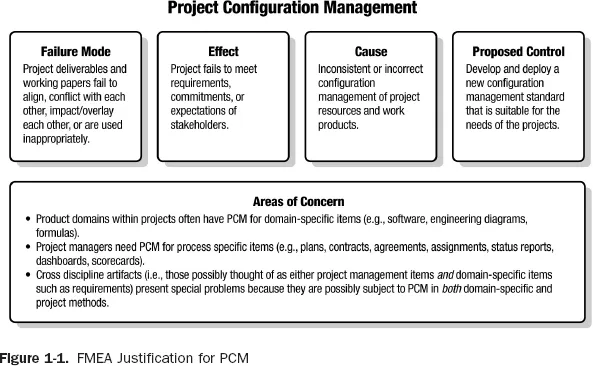![]()
Chapter 1
Introduction
Project Configuration Management (PCM) is the collective body of processes, activities, tools, and methods used to manage certain items during the project life cycle. These items are normally referred to as Configuration Items (CIs). Configuration management (CM) typically describes the mechanisms for managing the physical state of these items during their life cycle. As with any other profession, this body of knowledge rests with the practitioners who apply and advance it.
The Practice Standard on Project Configuration Management (PSPCM) is consistent with A Guide to the Project Management Body of Knowledge (PMBOK® Guide)–Third Edition, and provides additional information on the practice of PCM. The PSPCM spans all control functions found in Section 3 of the PMBOK® Guide–Third Edition, including the Integrated Change Control found in Chapter 4. The PSPCM describes the fundamentals of CM for practitioners of project management.
Objectives include:
- Explaining the concepts and benefits of CM in the context of project management
- Describing the types of processes used to apply CM as a project management tool
- Presenting good practices in CM in the context of project management
- Promoting a common lexicon for applying CM across projects.
This chapter defines and explains several terms, provides an overview of this standard, and includes the following major sections:
| 1.1 | Relationship with Other Standards |
| 1.2 | Purpose of this Practice Standard |
| 1.3 | How to Use this Practice Standard |
| 1.4 | What this Standard Is Not |
| 1.5 | Why Apply PCM? |
| 1.6 | Key Points |
| 1.7 | Audience |
1.1 Relationship with Other Standards
The PSPCM provides guidelines that are relevant to project managers and project teams on the requirements and responsibilities of a sound CM system for their project. The PSPCM is aligned with other PMI®, national, and international standards, as well as other common practices within the field of project management.
The following are examples of existing configuration management standards:
- ASME Y14.35M–1997 (R2003) Revision of Engineering Drawings and Associated Documents
- EIA/IEEE 649 National Consensus Standard for Configuration Management
- IEEE 1042-1987 (R1993) Guide to Software Configuration Management
- ISO 10007 Quality management systems—Guidelines for configuration management
The ASME and IEEE standards provide detailed guidance for specific disciplines and types of items. Many projects have CM requirements that are not described in such discipline-oriented standards. The EIA/IEEE 649 information is very detailed and prescriptive and may provide too much detail to be readily useful to a project manager. The guidelines in ISO 10007 provide very general and high-level information useful in understanding basic CM concepts. However, it does not provide a project manager with an understanding of the impact that CM can have on a project.
The PSPCM provides perspectives and insights applicable to all types of projects. Managing change is a regular responsibility for project management practitioners. Controlling change is the process of configuration control. CM is the parent of configuration control. The PSPCM provides guidance to the project manager and project team for establishing (or ensuring the establishment of) a sound CM process for the life of a project. This practice standard provides the what, when, and why of CM for implementation on projects.
1.2 Purpose of this Practice Standard
This standard provides guidance as to the most appropriate processes and tools in a well-designed configuration management system, thereby allowing the project, program, and portfolio managers to determine if appropriate controls are in place.
This standard is written for a wide audience that includes program managers, portfolio managers, project managers, project team members, and project stakeholders. PCM is generally recognized as a good practice for projects that are technical and non-technical, minor and major, foreign and domestic, and for projects within any industry.
1.3 How to Use this Practice Standard
This practice standard is intended to provide guidance on the processes and tools related to PCM. As a foundational reference, this standard is neither comprehensive nor all-inclusive, and may be used at the discretion of the project management team. This practice standard identifies and describes a subset of CM that is generally recognized as good practice for projects, and that is applicable to most projects most of the time. Readers should therefore use discretion in applying the information contained within this document to any specific project or situation. Appendices E, F, and G provide additional tools and information, including sources of further information regarding CM.
1.4 What this Practice Standard Is Not
This practice standard is not a textbook, regulation, or legal document. It is not industry-specific nor is it a how-to guide for CM.
1.5 Why Apply PCM?
Effective project management requires consistent and repeatable processes (or methodologies) to manage the constraints of scope, time, cost, and quality, and to ensure project success. The project management professional applies CM to actively support the project’s direction and infrastructure.
CM, applied over the life cycle of a configuration item, provides visibility and control of its performance, functional, and physical attributes. CM supports the following aspects of all configuration items (CIs) contained in any system:
- Integrity;
- Accountability;
- Visibility;
- Reproducibility;
- Coordination;
- Formal controllability; and
- Traceability.
To accomplish the preceding attributes, PCM may utilize consistent and reusable tools.
Within the processes of project planning, execution, and control, CM is critical. Figure 1-1 illustrates a failure mode and effect analysis (FMEA) that supports the use of PCM.
When PCM techniques are applied, many benefits are gained, including:
- Maintaining the integrity of CIs;
- Communication interfaces are clearer and contain applicable information;
- Records are available to support project or customer auditing requirements;
- Historical information regarding deliverable CIs can be utilized through the deliverable life;
- Integration between planning, execution, and change control help keep requirements and the end results of the project synchronized; and
- Ensuring only approved changes are incorporated into a revised configuration item.
1.6 Key Points
Some of the key points addressed within this practice standard are listed in this section. They are discussed within this practice standard and help clarify the depth of PCM.
CM planning often goes beyond the bounds of the project to ensure coordination of the project with its surrounding environment and to ensure integration of the project into a larger application if necessary. These external considerations should be documented as part of the project requirements in the earliest stages of a project to ensure that project integration is addressed, planned, and documented.
PCM requires human and system interfaces with other project processes to ensure that plans and priorities of CM align with those of the overall project plan. Clearly defined project interfaces for ensuring effective and efficient communications among the project stakeholders, suppliers, customers, and systems are needed for integration of CM requirements and compliance.
PCM provides a proactive perspective to the interdependent project management processes of initiating, planning, executing, controlling, and closing. This perspective addresses the planning for changes within all the project management processes as far in advance as possible.
CM is a well-established practice in many disciplines. However, projects are often cross-disciplinary endeavors, and specific disciplines often have their own configuration management strategies and procedures. A challenge for the project manager is to plan and execute PCM on project CIs while harmonizing with the CM needs and capabilities of all of the disciplines engaged in the project.
Controlling changes to approved project baselines is a fundamental PCM function. Early in planning, the project team should determine the project items requiring CM and the processes for managing them.
Some projects may be required to maintain configuration information under very strict controls mandated by a government or industry regulation. In these cases, external circumstances or organizational policies establish the processes and policies that the project will follow. These processes and policies are described in project plans, specifically in the documentation describing the change control system.
PCM ensures audit reports, summaries, checklists, action item status, deliverables, and other related documentation are retained and available in a timely and informative manner for stakeholders, project managers, and senior management to review at any point in time to determine the project’s health.
1.7 Audience
This practice standard provides a basic reference for anyone interested in PCM. This includes:
- Senior executives;
- Project managers;
- Project team members; and
- Stakeholders
- Consult...

